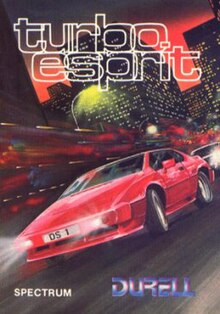
The ZX Spectrum is an 8-bit home computer developed and marketed by Sinclair Research. It is one of the most influential computers ever made, and it is also one of the best selling computers ever, with over five million units sold. It was first released in the United Kingdom on 23 April 1982, and around the world in the following years, most notably in Europe, the United States, and Eastern Bloc countries.

Out Run is an arcade driving video game released by Sega in September 1986. It is known for its pioneering hardware and graphics, nonlinear gameplay, a selectable soundtrack with music composed by Hiroshi Kawaguchi, and the hydraulic motion simulator deluxe arcade cabinet. The goal is to avoid traffic and reach one of five destinations.

Chase H.Q. is a vehicular combat racing game, originally released as an arcade video game by Taito in 1988. It is sometimes seen as a spiritual successor to Taito's earlier Full Throttle. The player assumes the role of a police officer named Tony Gibson, member of the "Chase Special Investigation Department". Along with his partner, Raymond Broady, he must stop fleeing criminals in high-speed pursuits in a black Porsche 928.

Knight Lore is a 1984 action-adventure game developed and published by Ultimate Play the Game, and written by company founders Chris and Tim Stamper. The game is known for its use of isometric graphics, which it further popularized in video games. In Knight Lore, the player character Sabreman has forty days to collect objects throughout a castle and brew a cure to his werewolf curse. Each castle room is depicted in monochrome on its own screen and consists of blocks to climb, obstacles to avoid, and puzzles to solve.

Crash, stylized as CRASH, is a magazine dedicated to the ZX Spectrum home computer, primarily focused on games. It was published from 1984 to 1991 by Newsfield Publications Ltd until their liquidation, and then until 1992 by Europress. It was relaunched as a quarterly A5 magazine in December 2020 with the backing of the original founders.

Stunt Car Racer is a racing video game developed by Geoff Crammond. It was published in 1989 by MicroProse, under their MicroStyle and MicroPlay labels in the United Kingdom and in the United States, respectively. The game pits two racers on an elevated track on which they race in a head-to-head competition, with ramps they must correctly drive off as the main obstacle.
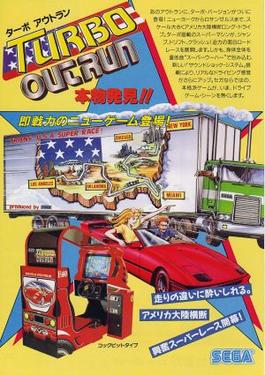
Turbo OutRun (ターボアウトラン) is a 1989 arcade racing game released by Sega. A follow-up to 1986's Out Run, it was released as a dedicated game, as well as an upgrade kit for the original Out Run board.
The Lotus series consists of three racing computer games based around the Lotus brand: Lotus Esprit Turbo Challenge, Lotus Turbo Challenge 2, and Lotus III: The Ultimate Challenge. Published between 1990 and 1992 by Gremlin Graphics, the games gained very favourable reviews upon release. Original Amiga versions of the games were created by Shaun Southern and Andrew Morris of Magnetic Fields, and then ported by other individuals to several other computers and game consoles.

Durell Software is a software developer based in Taunton, Somerset in the United Kingdom. The company is a provider of back office administration and accounting software to independent financial advisers, mortgage brokers, and general insurance brokers. Durell was formerly a successful video games developer.
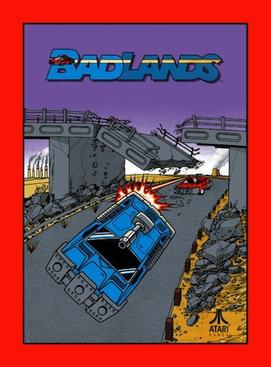
Badlands is a 1989 arcade video game published by Atari Games. It was ported by Domark under the Tengen label to the Amiga, Amstrad CPC, Atari ST, Commodore 64, and ZX Spectrum. The game is a re-themed version of Atari's previous racing games Super Sprint and Championship Sprint with the addition of vehicular combat. Badlands is set in the aftermath of a nuclear war and races around abandoned wastelands with many hazards. Three gun-equipped cars race around a track to win prizes.

Tau Ceti is a video game published in 1985 by CRL for the ZX Spectrum and converted to the Amstrad CPC, Amstrad PCW, Atari ST, Commodore 64, and MS-DOS. It was designed and programmed by Pete Cooke. The world, set on Tau Ceti III orbiting Tau Ceti, is displayed using 3D graphics with shadow effects. The planet has a day and night cycle.

A Grand Theft Auto clone belongs to a subgenre of open world action-adventure video games, characterized by their likeness to the Grand Theft Auto series in either gameplay, or overall design. In these types of open world games, players may find and use a variety of vehicles and weapons while roaming freely in an open world setting. The objective of Grand Theft Auto clones is to complete a sequence of core missions involving driving and shooting, but often side-missions and minigames are added to improve replay value. The storylines of games in this subgenre typically have strong themes of crime, violence and other controversial elements such as drugs and sexually explicit content.
Mikro-Gen was a UK software company based in Bracknell, Berkshire that produced games for home computers in the early to mid-1980s.

Silkworm is a horizontally scrolling shooter developed by Tecmo and first released for arcades in 1988. In 1989 it was ported to the Amiga, Atari ST, Commodore 64, ZX Spectrum, Amstrad CPC and NES (1990) systems by The Sales Curve and released by Virgin Mastertronic.
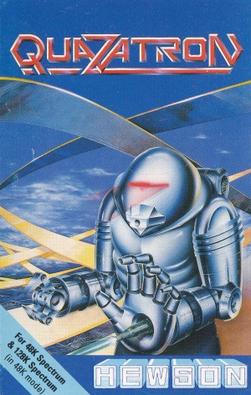
Quazatron is an action game developed by Graftgold, and released in 1986 by Hewson Consultants. It was designed by Steve Turner for the ZX Spectrum.
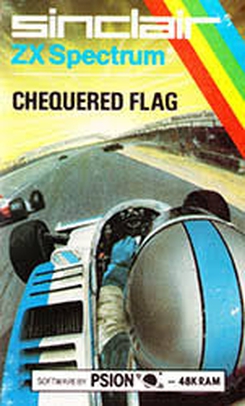
Chequered Flag is a racing video game developed by Psion Software and published by Sinclair Research in 1983. It was the first driving game published for the ZX Spectrum and one of the first computer car simulators.

Agent X, also known as Agent X in the Brain Drain Caper, is a computer game released in 1986 for the ZX Spectrum. The player takes control of the eponymous Agent X in a multi-load game made up of a number of sub-games. It was followed by a sequel, Agent X II: The Mad Prof's Back.

Miami Vice is an action video game developed by Canvas and published by Ocean Software. It was first released in the United Kingdom for the Amstrad CPC, Commodore 64, and ZX Spectrum in 1986. It was later re-released in Germany and Italy for the Commodore 64 in 1989. The game is based on the television series of the same name and follows the two central characters, James "Sonny" Crockett and Ricardo Tubbs, as they attempt to derail a Miami drug ring which is led by series antagonist "Mr J".

Thanatos is an action game developed and published by Durell Software in 1986 for the ZX Spectrum, Commodore 64 and Amstrad CPC.

Battlecars is a vehicular combat game released for the ZX Spectrum in 1984. It is based on Games Workshop's miniature wargame, Battlecars. The game is set in 2084 in a future where road accidents have been eliminated by technology, and the world is relatively bloodless; however, people now entertain themselves by drivers using 20th century automobiles in violent, gladiatorial contests.
